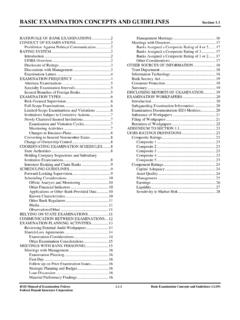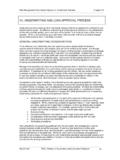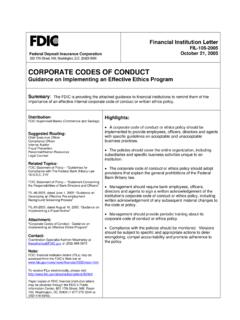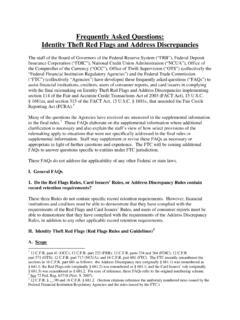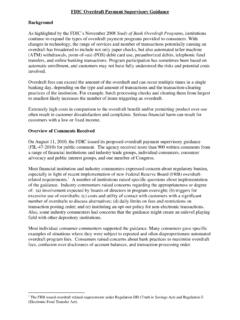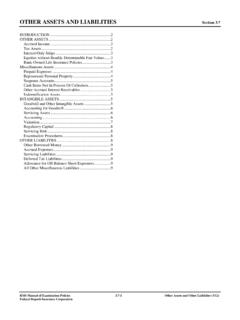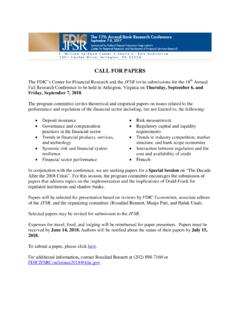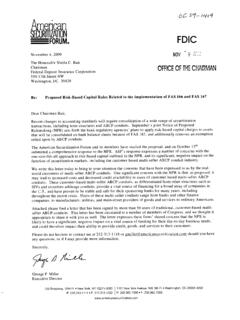Transcription of Home Mortgage Disclosure Act 1 - FDIC: Federal Deposit ...
1 V. Lending HMD A FDIC Consumer Compliance Examination Manual Jul y 2021 V Home Mortgage Disclosure A ct1 Back g round The Home M ortgage Disclosure Act requires certain financial institutions to collect, rep ort, and disclose information about their Mortgage lending activity . HM DA was originally enacted by the Congress in 1975 and is imp lemented by Regulation C (12 CFR Part 1003). HM DA was enacted given p ublic concern over credit shortages in certain neighborhoods. In p articular, Congress believed that some financial institutions had contributed to the decline of various geograp hic areas through their failure to p rovide adequate home financing to qualified ap p licants on reasonable terms and conditions. Thus, one statutory p urpose of HM DA is to p rovide the p ublic with information that will help show whether financial institutions are serving the housing credit needs of the communities and neighborhoods in which they are located.
2 A second statutory p urpose is to aid p ublic officials in distributing p ublic sector investment so as to at t ract p rivat e invest ment t o areas where it is needed. Finally , the Financial Institutions Reform, Recovery , and Enforcement Act of 1989 (FIRREA) amended HM DA to require the collection and Disclosure of data about ap p licant and borrower characteristics to assist in identify ing p ossible discriminatory lending p atterns and enforcing antidiscrimination statutes. As t he name imp lies, HM DA is a Disclosure law t hat relies up on p ublic scrutiny for its effectiveness. It does not p rohibit any sp ecific activity of lenders, and it does not establish a quota sy stem of Mortgage loans to be made in any geograp hic area. Between 1988 and 1992, Congress amended HM DA s coverage. Coverage was exp anded in the FIRREA amendments to include many indep endent nondep ository Mortgage lenders, in addition to the p reviously covered banks, savings associations, and credit unions.
3 Coverage of indep endent Mortgage bankers was further exp anded by the Federal Dep osit Insurance Corp oration Imp rovement Act of 1991 HM DA amendments. For a more detailed discussion of the history of HM DA, see the Federal Financial Institutions Examination Council s (FFIEC) website at Prior to the Dodd-Frank Wall Street Reform and Consumer Protection Act of 2010 (Dodd-Frank Act), HM DA required financial inst it ut ions to rep ort data regarding ap p lications, loan originations, and loan p urchases, as well as certain requests _ _ _ _ __ ____ ____ ____ __ 1 12 USC 2801 2810. The HMDA Interagency Examination Procedures cover HMDA data collected in or after 2018, that is, for loans and applications for which final action was taken in or after 2018. 2 In December 2011, the Bureau restated the FRB s existing Regulation C at 12 CFR 1003. See 76 Fed. Reg. 78465 (Dec. 19, 2011). 3 80 Fed.
4 Reg. 66128 (Oct. 28, 2015). under a p re-ap p roval p rogram (as defined in Regulation C). HM DA also required financial institutions to rep ort certain ap p licant and borrower demograp hic data, such as ethnicity , race, gender, and gross income. In addition, the rep orting of certain p ricing information and the ty p e of p urchaser was required. Data was rep orted in a register rep orting format, comp iled by sup ervisory agencies, and disclosed to the p ublic. The Dodd-Frank Act amended HM DA to, among other things, require rep orting of additional data p oints, transfer HM DA rulemaking authority from the Board of Governors of the Federal Reserve Sy stem (FRB) to the Consumer Financial Protection Bureau (Bureau), and p rovide the Bureau with authority to mandate collection, recording, and rep orting of such other information as the Bureau may In August 2014, the Bureau p rop osed amendments to Regulation C to imp lement t he Dodd-Frank Act changes; to require collection, recording, and rep orting of additional information to further HM DA s p urposes; and to modernize the manner in which covered financial institutions rep ort HMDA data.
5 The Bureau p ublished a final rule amending Regulation C in October 2015 (2015 HM DA Rule).3 The Bureau p ublished a final rule further amending Regulation C in Sep tember 2017 to facilitate imp lementation of the 2015 HM DA Rule (2017 HM DA Rule).4 Beginning in 2018, as discussed further below, the 2015 HM DA Rule requires that financial institutions continue to rep ort data regarding ap p lications, loan originations, and loan p urchases. The Bureau s 2015 HM DA Rule changed: (1) the definition of a financial institution that is subject to Regulation C; (2) the ty p es of transactions that are subject to Regulation C; (3) the data that financial institutions are required to collect, record, and rep ort p ursuant to Regulation C; and (4) the p rocesses for rep orting and disclosing HM DA data. The data are submit t ed elect ronically to the Bureau on behalf of the ap p rop riat e Federal agency associat ed wit h t he rep ort er, and most of the data are made available to the p ublic on both an aggregat e and a loan-level On M ay 24, 2018, the President signed the Economic Growth, regulatory Relief, and Consumer Protection Act (2018 Act) int o Effective M ay 24, 2018, Section 104(a) of the 2018 Act created p artial exemp tions from some of HM DA s requirements for certain covered institutions.
6 On August 31, 2018, the Bureau issued an interp retive and p rocedural rule (2018 HM DA Rule) to imp lement and clarify Section 104(a) 4 82 Fed. Reg. 43088 (Sept. 13, 2017). 5 Information about the HMDA Platform through which financial institutions submit HMDA data to the Bureau to be processed and disclosed is available at 6 Pub. L. 115-174, 132 Stat. 1296 (2018), Section 104(a) (codified at 12 USC 2803). V. Lending HMD A V FDIC Consumer Compliance Examination Manual July 2021 of the 2018 Act (2018 HM DA Rule). The 2018 HM DA Rule was p ublished in the Federal Register on Sep tember 7, On Ap ril 16, 2020, the Bureau issued a final rule t o increase the coverage threshold related to closed-end Mortgage loan activity , among other changes (2020 HM DA Rule). The 2020 HM DA Rule was p ublished in the Federal Register on M ay 12, Effective July 1, 2020, the origination threshold for coverage wit h resp ect t o closed-end Mortgage loans increased from at least 25 originations to at least 100 originations in each of the p receding two calendar y ears.
7 The Federal sup ervisory agencies use HM DA data to sup p ort a variet y of act ivit For examp le, some Federal sup ervisory agencies use HM DA dat a as p art of t heir fair lending examination p rocess, and ot her agencies use HM DA dat a in conducting Community Reinvestment Act (CRA) p erformance M oreover, HM DA disclosures p rovide the p ublic with information on the home Mortgage lending activities of p articular rep orting entities and on activity in their communities. These disclosures are used by local, State, and Federal officials to evaluate housing trends and issues and by community organizations to monitor financial institution lending p atterns. Because HM DA data serve numerous imp ortant p urp oses, validating the accuracy of HM DA data is a key element of t he Federal sup ervisory agencies examinat ion act ivit ies. Coverag e A. Institutional Coverage Institutional Coverage Generally An institution is required to comp ly with Regulation C only if it is a financial institution as that term is defined in Regulation C.
8 The definition of financial institution includes both dep ository financial institutions and nondep ository financial inst itutions, as those terms are sep arately defined in Regulation C. 12 CFR (g). An institution uses these two definitions, which are outlined below, as coverage t est s t o det ermine whet her it is a financial institution that is required to comp ly with Regulation C. For the p urp ose of these examination p rocedures, the term financial institution refers to an institution that is either a dep ository financial institution or a nondep ository financial institution that is subject to Regulation C. _ _ _ _ __ ____ ____ ____ __ 7 83 Fed. Reg. 45325 (Sept. 7, 2018). 8 85 Fed. Reg. 28364 (May 12, 2020). Insti tuti onal Coverage Tests Dep ository Financial Institutions A bank, savings association, or credit union is a dep ository financial institution and subject to Regulation C if it meets ALL of the following: 1.
9 Asset-S i ze Thre shold. On the p receding December 31, the bank, savings association, or credit union had assets in excess of t he asset-size threshold p ublished annually in the Federal Register, as included in the Official Interp retations, 12 CFR Part 1003, Comment 2(g)-2, and p osted on the Bureau s website. 12 CFR (g)(1)(i). The p hrase p receding December 31 refers to the December 31 immediat ely p receding t he current calendar y ear. For examp le, in 2019, the p receding December 31 is December 31, 2018. Comment 2(g)-1. 2. Location Test. On the p receding December 31, the bank, savings association, or credit union had a home or branch office located in a metrop olitan statistical area (M SA). 12 CFR (g)(1)(ii). For p urp oses of this location test, a branch office for a bank, savings association, or credit union is an office: (a) of the bank, savings association, or credit union (b) that is considered a branch by the institution s Federal or State sup ervisory agency.
10 For p urp oses of Regulation C, an aut omat ed t eller machine or other free-standing electronic terminal is not a branch office regardless of whether the sup ervisory agency would consider it a branch. 12 CFR (c)(1). A branch office of a credit union is any office where member account s are est ablished or loans are made, whet her or not a Federal or St at e agency has ap p roved the office as a branch. Comment 2(c)(1)-1. 3. Loan-Activity Test. During the p receding calendar y ear, the bank, savings association, or credit union originated at least one home p urchase loan or refinancing of a home p urchase loan secured by a first lien on a one-to-four-unit dwelling. 12 CFR (g)(1)(iii). For more information on whether a loan is secured by a dwelling, is a home p urchase loan, or is a refinancing, see 12 CFR (f), (j), and (p ) and associated commentary . 4. Federally Related Test.
